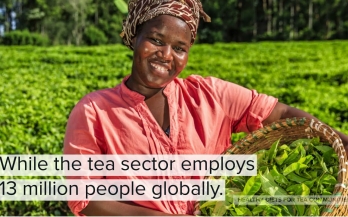Tea is now the second-most consumed beverage worldwide after water. More than 2 billion people globally consume tea at least once per day, and the industry continues to grow. It now employs more than 13 million people in tea production, including 9 million smallholder farmers – with 70% of global production from 8 million smallholder farmers in Asia and Africa alone.
Historically, workers in the tea industry may not have diets of good nutrition, resulting in high rates of anaemia and hypertension, and even increasing overweight rates. These can result in low morale, reduced concentration and increased fatigue for workers, and cause low productivity and even increased safety issues for a company.
Now, through an innovative partnership between the tea sector, through the Ethical Tea Partnership (ETP), and the Global Alliance for Improved Nutrition (GAIN), activities are under way to bring good nutrition to tea workers, their families, and even their communities.
The Healthy Diets for Everyone in Tea Communities programme, is a sector-wide nutrition programme in Africa and Asia led by GAIN and ETP and funded by both private and public sector partners. The contribution of Unilever, Taylors of Harrogate, Republic of Tea, Jacob Douwe Egberts, Ringtons Foundation, Wollenhaupt, Reginald Ames and Bigelow is matched by the Dutch Ministry of Foreign Affairs.
The programme aims to reach an impressive 750,00 tea farmers, workers and community members in India, Kenya and Malawi by 2023.
Kenya
Kenya is the third-largest tea producer in the world after China and India. The country’s smallholder sub-sector accounts for over 60 per cent of total production from 54 registered tea factories serving over 400,000 growers. Large plantation tea estates make up the remaining 40% of production, and include 39 factories.
In Kenya, the Healthy Diets for Everyone in Tea Communities programme was launched in March 2021 in Kericho County, one of Kenya’s top tea-producing counties. It seeks to bring good nutrition to 26,000 direct beneficiaries and about 110,000 indirect beneficiaries.
The programme’s launch event was attended by more than 65 key programme partners and stakeholders including farmers and representatives from the Kenya Tea Development Agency (KTDA), KTDA Foundation, Ministry of Health, county officials, and tea estates and processing factories. This played an important dual role in raising awareness for good nutrition for tea farmers in Kericho County, and in reaffirming the support of county government officials and national level government leaders with the ministries of agriculture, trade and health.
The programme was kicked off that same month at events at four tea factories in Kericho Country with the participation, at each, of the factory’s chairman of the board and unit managers, together with the programme’s field services coordinators, GAIN staff, ETP staff, KTDA Foundation staff, and project assistants.

Kenya is the third-largest tea producer in the world after China and India. The country’s smallholder sub-sector accounts for over 60 per cent of total production from 54 registered tea factories serving over 400,000 growers. © Unsplash / Arfan Abdulazeez
These inception meetings helped to increase awareness for the importance of good nutrition within the tea sector, and to provide stakeholders with information on the programme’s planned activities. They also served, importantly, to leverage the support of stakeholders towards the success and sustainability of the activities.
Since launching earlier this year, the programme has initiated several key activities.
Baseline survey
A baseline survey was carried out 13-26 March 2021 by IPE with support from GAIN and KTDA Foundation staff. It measured knowledge and perceptions on nutritious diet, food security experience scale, and dietary diversity in women of reproductive age 18-49 yrs. It also measured the availability of nutritious and safe food in the local market, affordability of nutritious and safe foods, knowledge and practices related to drinking water, gender aspect in decision making, and coping skills.
Understanding how the issue of nutrition impacts women was key to the team, as women make up the large majority of tea sector workers in Kenya, as elsewhere. At Tegat and Toror factories in Kenya, they make up 55% of the workforce, while at Kapkatet and Tebesonik factories they make up 65% of the workforce.
As part of this initiative, local community members were trained in how to conduct the surveys and carried out the surveys themselves in the local language. Using community members to conduct the surveys gained acceptance from participants, and also enabled a maximum number of participants, as the surveyors knew the areas well.
The results of the baseline survey are now being used to identify the most appropriate and effective actions that the programme can implement to help bring good nutrition and healthy diet choices to the tea workers and their families.
Nutrition education via SMS
The programme has now also partnered with Safaricom – Kenya’s leading digital provider – to bring information on good nutrition to tea farmers, their families and their communities via SMS messaging on their mobile phones.
Currently 5,000 farmers take part in the initiative, and receive daily messages developed by nutrition experts with GAIN and founded on scientific knowledge of good nutrition practices.
The messages cover a variety of nutrition related topics from the importance of diet diversification to the nutritive value of different food groups, and healthy diet choices. The messages are designed to positively impact the behaviour of farmers, so that they and their families increase their healthy diet choices.
Engaging information, education and communication materials
In addition to information shared digitally via SMS, the programme is also using more traditional methods of communicating information about good nutrition. These are also proving useful during the COVID-19 pandemic when live interactions may be restricted.
Engaging education posters, hand fliers, and pamphlets are being distributed to ensure that information cascades down to every farmer and every worker in the target area.
The posters are being placed at strategic locations such as the tea buying centers, factory notice boards and health facilities; while the handouts are being given to farmers and their families attending nutrition trainings at the buying centers. The posters will also be seen and read by the wider community, reaching thousands of more people.
Food kiosk workers
The programme team also identified the significant potential to reach families and the wider community through the local food kiosk workers. The food kiosk vendors are the source of food for more than 90% of the tea farming families. They also play an important role in the availability of healthy foods in the community, as they buy products from markets outside the community and bring them to the community, and are essentially the end of the food distribution chain for these tea farmer communities.
The programme works with the food kiosk workers to both encourage them, as micro-entrepreneurs, to buy and sell more nutrition food items; and to also provide them with knowledge about nutritious foods that they can share with their customers. In this way, they both stimulate demand for nutritious foods and act as positive influencers within their communities.
As part of the initiative, the food kiosk vendors take part in either group training sessions, or are guided one-to-one by the programme’s staff. They are also provided with food tags that note key nutritional information for selected food items, which is translated into the local language.
At least 100 food kiosk vendors are taking part in the programme, reaching men, women and children within the tea farming community – and helping to improve the consumption of nutritionally beneficial foods by tea growing farmers and their families, and throughout the wider community within Kericho County.
Scaling up availability of high nutrient value locally available foods
In order to promote household nutrition security, the programme is also supporting smallholder farmers to keep kitchen gardens and to grow nutritious staple foods. This has included orange fleshed sweet potatoes, which are rich in vitamin A, beans high in iron, and locally available fruits and vegetables that are high in vitamin A and vitamin C.
Nutrition trainings at the tea buying centres
The programme is also leveraging the existing community health strategy and is collaborating with the county government to expand the demand for nutritious foods within the communities. As part of this, the programme support community health volunteers to carry out nutrition training sessions at every tea buying centre attached to the four tea factories taking part in the programme. This is then coupled with practical cooking demonstration sessions that teach participants how to cook nutritious food items in ways that will retain their essential nutrients.
Mass media communication
The programme is also turning to more traditional media – particularly local FM radio stations – to reach large audiences with nutrition information, with the goal to create more demand for nutritious foods. This has included radio spots on healthy diet choices as well as radio talk shows produced in collaboration with the department of Health promotion at the Ministry of Health and with the Ministry of Agriculture. This has included content specifically designed to target small-scale tea farmers and tea workers, and to provide them with more awareness about the benefits of healthy diets.
Workforce nutrition
These exciting initiatives are just some examples of how the private sector can support the health and wellbeing of their employees and the communities in which they operate through workforce nutrition programmes. These programmes seek to bring good nutrition to employees through four key pillars – good food at work, nutrition education, breastfeeding support and nutrition health checks.
The Healthy Diets for Everyone in Tea Communities focuses on bringing the pillar of nutrition education to the tea sector workforce to build a healthier, stronger and more resilient workforce and industry – improving the livelihoods of 750,000 people.
To learn more about the Healthy Diets for Everyone in Tea Communities programme, visit GAIN and ETP.
To learn more about Workforce Nutrition, visit the Workforce Nutrition Alliance
Videos

For more videos, please visit our youtube channel